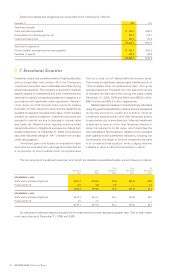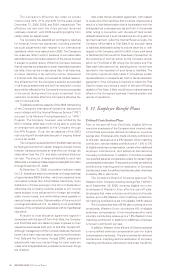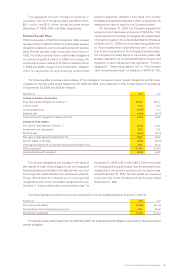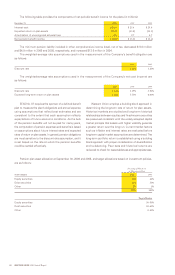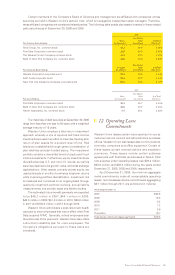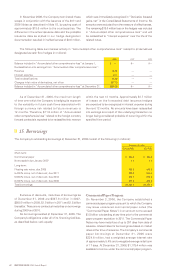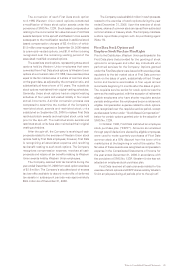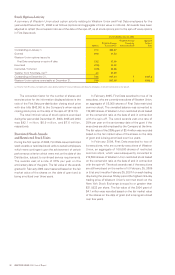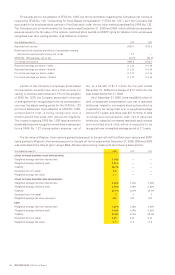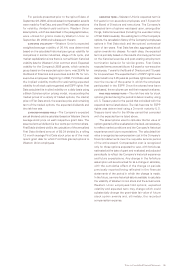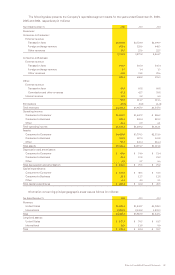Western Union 2006 Annual Report Download - page 89
Download and view the complete annual report
Please find page 89 of the 2006 Western Union annual report below. You can navigate through the pages in the report by either clicking on the pages listed below, or by using the keyword search tool below to find specific information within the annual report.
Notes to Consolidated Financial Statements 87
The Company previously restated its financial
statements for certain derivatives originally intended to
qualify as cash flow hedges in accordance with SFAS
No. 133. On September 29, 2006, the Company either
settled its outstanding derivatives that were determined
to not qualify for hedge accounting or offset such
derivatives with new derivatives that were not designated
as hedges in accordance with SFAS No. 133. As such, the
effect of the changes in the fair value of these hedges
prior to September 29, 2006 is included in “Derivative
(losses)/gains, net.” On September 29, 2006 and during
the fourth quarter of 2006, the Company entered into new
derivative contracts in accordance with its revised foreign
currency derivatives and hedging processes, which were
designated and qualify as cash flow hedges under SFAS
No. 133.
The Company does not believe its derivative financial
instruments expose it to more than a nominal amount
of credit risk as the counterparties are established,
well-capitalized financial institutions with credit ratings of
“A” or better from major rating agencies. The credit risk
inherent in these agreements represents the possibility
that a loss may occur from the nonperformance of a
counterparty to the agreements. The Company performs
a review of the credit risk of these counterparties at
the inception of the hedge, on a quarterly basis and
as circumstances warrant. The Company also monitors
the concentration of its contracts with any individual
counterparty. The Company anticipates that the
counterparties will be able to fully satisfy their obligations
under the agreements. The Company’s exposures are in
liquid currencies, so there is minimal risk that appropriate
derivatives to maintain the hedging program would not be
available in the future.
The details of each designated hedging relationship
are formally documented at the inception of the
arrangement, including the risk management objective,
hedging strategy, hedged item, specific risks being hedged,
the derivative instrument, how effectiveness is being
assessed and how ineffectiveness, if any, will be measured.
The derivative must be highly effective in offsetting the
changes in cash flows, and effectiveness is continually
evaluated on a retrospective and prospective basis. The
Company assesses the effectiveness of its foreign currency
forward contracts, used to mitigate some of the risks
related to forecasted revenues, based on changes in the
spot rate of the affected currencies during the period
of designation. Accordingly, all changes in the fair value
of the hedges not considered effective are recognized
immediately in “Derivative (losses)/gains, net” within the
Company’s Consolidated Statements of Income. Changes
in the fair value due to the interest rate differential between
the two currencies, and all changes in the fair value during
periods in which the instrument was not designated as a
hedge, were excluded from the measure of effectiveness
and resulted in a $1.5 million gain during the year ended
December 31, 2006.
The aggregate United States dollar equivalent notional amount of foreign currency forward contracts held by the
Company with external third parties as of the balance sheet dates are as follows (in millions):
December 31, 2006 2005
Contracts not designated as hedges:
Euro $249.5 $497.8
British pound 43.5 82.0
Other 51.1 78.1
Contracts designated as hedges:
Euro 333.9 —
British pound 73.2 —
As of December 31, 2006 and 2005, the carrying value
and fair value of the Company’s foreign currency forward
contracts with external third parties was a $12.2 million
net liability and an $18.3 million net asset, respectively, as
disclosed in Note 9.
The aggregate notional amount of foreign currency
swap arrangements held by the Company with First Data
affiliates totaled 238.1 million euros at December 31, 2005.
The fair market value of these swaps ($7.2 million asset
as of December 31, 2005) was settled in cash along with
the related notes receivable in connection with the spin-off
on September 29, 2006 (Note 1).
In October 2006, the Company executed forward
starting interest rate swaps with a combined notional
amount of $875 million to fix the interest rate in connection
with an anticipated issuance of fixed rate debt securities
expected to be issued between October 2006 and May
2007. The Company designated these derivatives as cash
flow hedges of the variability in the cash outflows of interest
payments on the first $875 million of the forecasted debt
issuance due to changes in the benchmark interest rate.
The swaps were expected to be highly effective in hedging
the interest payments associated with the forecasted debt
issuance as the terms of the hedges, including the life and
notional amount, mirrored the probable issuance dates of
the forecasted debt issuances, and statistical analyses of
historical relationships indicated a high correlation between
spot and forward swap rates for all possible issuance dates
within the expected range of issuance dates.



